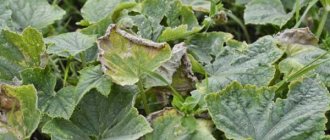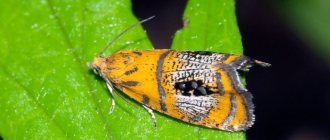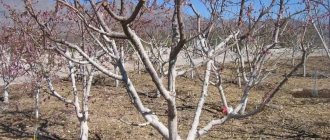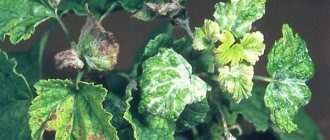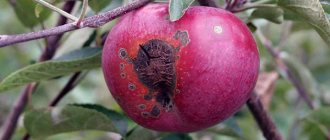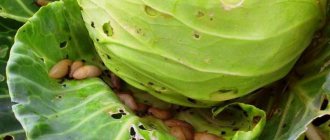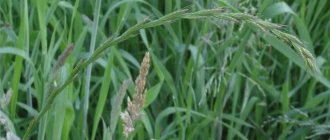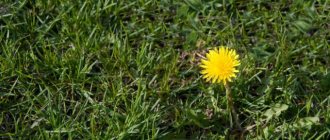What does a cruciferous flea beetle look like (description and photo)
The cruciferous flea beetle is a shiny black bug that damages plants of the cruciferous family. Favorite plants for pests to eat are cabbage seedlings, radishes, radishes, turnips, arugula, etc. Heat-loving beetles prefer to feed on the apical and illuminated leaves, the damage increases in hot, dry sunny weather. Then their gluttony increases significantly.
By June, the aggressiveness of pests decreases. But here comes the second dangerous period - the time of reproduction. Females begin to lay eggs in the surface layer of soil. The eggs take approximately 12 days to develop. The hatched larvae feed on the roots of cruciferous crops and do not cause much harm. The development of larvae lasts 15-20 days. Pupation also occurs in the soil and after about 2 weeks a new generation of beetles is born.
Having emerged on the soil surface in the second half of July, the bugs begin to feed on the leaves of already strong plants. Of course, the harm from them during this period will be much less. They can damage flowers and seed fruits of vegetable crops. However, if no measures are taken to destroy the pests, with the onset of cold weather in the fall, the beetles return to the soil for the winter. And the breeding cycle repeats next spring. Look at the photo to see what the cruciferous flea flea looks like.
Description of the pest
The cruciferous flea beetle looks like a miniature beetle, the size of which is 0.15-0.3 cm. The insect is also known as the cabbage flea beetle or black flea beetle. The body of the beetle has an oval-oblong shape. The insect has whiskers, the length of which is equal to less than a third of the body.
The beetle moves by jumping on its hind legs. There are many varieties of flea beetles, differing in the color of their elytra. The adult insect feeds on foliage, and the larvae feed on weak parts of the roots.
Cruciferous flea flea - how to fight it using folk methods
Since pest beetles prefer to feed on young leaves of cruciferous crops, the fight against them must begin literally with the appearance of the first shoots. The real danger awaits the seedlings when the first seven-lobed leaves appear on them. Do not wait for fleas to appear, they can instantly jump over a number of growing weeds, start fighting immediately.
Remove all weeds from the bed where radishes, cabbage or turnips grow, loosen the soil between the rows. And then cover the seedlings with a light sponbond, securing it on the sides with stones or boards so that the covering material does not blow away in the wind. The sponbond will protect the seedlings from insects, and water will pass through it well during watering and rain, so the plantings will not suffer from lack of moisture.
If there is no covering material, plantings are dusted using
- tobacco dust,
- wood ash,
- a mixture of wood ash and tobacco dust,
- ash and street dust,
- a mixture of cement powder and street dust.
It is best to pour the prepared powders into a sieve or one layer of gauze, and then sprinkle the plants from them. It is better to treat plantings early in the morning, when the plants remain damp from dew or evening watering. Dusting is not carried out on dry grass. When sprinkling dry foliage, the slightest wind will blow the powder off the leaves, and the treatment will not give any results.
The use of various repellent plants shows good results. Thus, the aroma of marigolds, calendula, garlic, coriander, dill, and wormwood planted next to cabbage, radishes or turnips will repel pests. Moreover, the effect will also be from the dry grass of these plants laid out next to cruciferous crops.
Prevention measures
It is easier to prevent any problem than to deal with its consequences later. Therefore, experts and experienced gardeners recommend several prevention methods that will help protect radishes. Let's consider. what needs to be done to protect the plantings from the pest at the initial stage.
The proximity of coriander, dill and garlic repels the pest, since the insect really does not like the smell of these plants. When radishes are planted towards the end of the season, it is recommended to place the beds next to calendula or marigolds, which the flea beetle also cannot tolerate.
When watering seedlings, it would be useful to add products that have a strong odor to the water, for example, tincture of valerian or Corvalol. It is enough to use 15 drops per bucket of water, and spray or water the beds with this liquid, the smell will repel the parasite. For the same reason, fresh wormwood laid out on the garden bed is an effective remedy.
Regular removal of weeds will help reduce the number of insects. In addition, radishes need to be provided with nutrients, since parasites prefer weak and small seedlings. It is also recommended to sow the crop as early as possible, when the flea beetle has not yet emerged from hibernation, which will give the radishes time to get stronger. If the above preventive measures are observed, there is a chance to prevent the spread of the pest in the garden.
How to get rid of cruciferous flea beetle on cabbage and radishes
There are other folk ways to combat fleas. After all, chemicals cannot always be used. For example, radish is an early ripening crop; the use of chemicals is not advisable for it. Therefore, take into account the products that are used to spray the plants.
- Birch tar . For 1 liter of water add 1 tsp. tar, shake well in water. Since birch tar does not dissolve well and settles on the walls of the watering can, experienced gardeners advise first stirring the tar with liquid soap, and then slowly adding water and only then spraying the plants.
- Ash infusion . Pour boiling water over the wood ash in a ratio of 1:3, leave to steep for two days, then strain and add liquid or soaked laundry soap, then spray the plantings.
- Garlic solution . Pass 1 cup of garlic and the same number of tomatoes through a meat grinder. Dilute the mixture with 10 liters of water, strain, add 1 tbsp. l. liquid soap and start spraying.
- Solution with dandelions . Grind 500 g of dandelion leaves and roots in a meat grinder, dilute the mixture in 10 liters of water, strain. Add 1 tbsp. l. soap The solution is ready for use.
How to fight cruciferous flea beetle with vinegar
Pests do not like strong odors; the use of table vinegar is based on this property; it has a detrimental effect on bugs. If you take vinegar essence, then dilute it at the rate of 1 tbsp. l. essences per 10 liters of water. When using 9% table vinegar, it is enough to dilute 1 tsp. for 1 liter of water. Remember that you need to spray on dry foliage.
Ammonia to combat cruciferous flea beetle
To prepare the working solution, 1 tsp. ammonia is diluted in 1 liter of water, stirred and sprayed on the plants. The treatment is carried out on dry leaves. When treating with ammonia, in addition to repelling pests, you also fertilize. Ammonia is like a nitrogen plant.
A similar action - processing and fertilizing at the same time - is used when using a weak solution of chicken manure. The leaves, absorbing nitrogen fertilizing, will develop faster, gain strength, and become stronger. The coarsened leaves will no longer be suitable for the bugs and they will not eat them willingly.
Chemicals to combat cruciferous flea beetle
The use of chemical insecticides is sometimes not justified, since some crops have a short growing season. Chemicals can be used no earlier than 20 days before harvesting vegetables. If you notice more than 5-7 insects on one plant, then you can’t do without chemicals. And if you decide to use them, choose the most harmless ones.
The most effective and frequently used means:
- Actellik is a drug from the Swiss company Syngenta. The product protects plants well from many pests, including the Colorado potato beetle. Easy to use, just dilute the concentrated emulsion with water and the product is ready for use. Economical: one ampoule of the product (2 ml) is diluted in 2 liters of water; if the pest population is larger, the contents of the ampoule are diluted in 1 liter of water. The death of insects occurs after 10 minutes for 5-6 hours.
- Aktara is a contact-intestinal insecticide that begins to act on pests half an hour after spraying the plants, maintaining effectiveness for 3-5 weeks. Before use, 3 g of the product is diluted in 10 liters of warm water. The product does not accumulate in plants and fruits and is not addictive to insects. However, it is quite effective on other insects, so it is not used during flowering so as not to cause the death of bees.
- Intavir is a universal, inexpensive, effective drug - a tablet used to destroy a large number of pests. It is quite simple to use; you need to dissolve 1 tablet in a small amount of warm water, and then increase the volume of liquid to 1 liter and spray the plants with the resulting solution. During processing, the plant itself is not damaged, but the death of insects occurs as a result of paralysis, due to which the insect stops moving, feeding and dies.
- Bankol is a biological, low-toxic drug that quickly decomposes in the soil, but with its help you can get rid of pests in one treatment. The main active ingredient of Bankol is bensultap, a neurotoxin of annelid sea worms. This product does not accumulate in treated plants, soil or water. Before use, the product is first diluted in a small amount of water, then the volume of the solution is adjusted to 5 liters and the plants are sprayed. The drug acts on bugs through contact and through the intestines, the pests stop moving and feeding, and as a result die within 1-3 days.
Chemical treatment is carried out in dry, windless weather on dry foliage. If it rains within 1-2 hours after treatment, the treatment must be repeated. Also, do not water the plants immediately after treatment.
When using chemicals, always carefully read the instructions for use of the drug, dilute the drugs and work using protective equipment.
Proven folk recipes
Folk remedies against cruciferous flea beetle have been accumulated for decades. The most effective and well-proven among gardeners are the following:
- Dusting plants with wood ash or tobacco dust, lime, shag, and ground pepper. It has been noticed that the beetles are unusually “clean” and do not attack dirty leaves. The most inventive gardeners sprinkle young shoots with stove soot. After precipitation, the procedure is repeated.
- Planting plants along the beds that will repel cruciferous flea beetles with their aroma. These include garlic, dill, calendula, coriander, and marigolds.
- Fresh or dried wormwood grass is laid out near the holes.
Plants can be treated against cruciferous flea beetle with the following decoctions and tinctures:
- a bucket of water, 2 cups of ash and 50 g of crushed tar or green soap;
- to spray the leaves, mix a liter of water and a glass of vinegar;
- Chop 250 g of freshly cut dandelions along with rhizomes and add 5 liters of warm water, let it brew, add a bar of soap to improve adhesion;
- prepare a mixture of tomato tops (1 cup) and a cup of garlic in the same way;
- an infusion of chicken manure (1:20) is infused for several days, after which the foliage is sprayed with it.
On a note! It is advisable to spray plants in the morning or evening hours.
How to poison cruciferous flea beetle on strawberries
Some gardeners complain that the cruciferous flea beetle appears on strawberry bushes. Strawberries do not belong to the cruciferous family and the appearance of bugs on strawberry leaves only indicates that cruciferous plants grow nearby - radishes, turnips, cabbage. etc.
A fairly common reason for the appearance of pests on strawberries is the proximity to planted green manure - rapeseed and mustard. Since bugs are highly mobile and easily move from one plant to another, it is not surprising that pests are found here too.
But the voracious insect does not disdain strawberry leaves, eating both old and young leaves. In order to somehow preserve the harvest, if you find fleas on strawberry leaves, you need to urgently get rid of them. Since strawberries quickly begin to bloom and then bear fruit, chemicals obviously will not help. Therefore, it is better to use folk remedies: dusting with wood ash, tobacco dust, spraying with solutions of vinegar, ammonia, infusions of strong-smelling plants.
Radish pests in a greenhouse
Fighting ants in the garden using folk remedies
Insect pests can harm radish plantings not only in open ground, but also in greenhouses. Most often, in greenhouse conditions, radishes are attacked by cruciferous flea beetles. They chew on radish leaves, creating holes in them. Sometimes novice gardeners do not know what to do if through holes appear on the radish leaves and what to treat with. If there are black flea beetles on radishes, what should you do to protect the plant?
You can fight fleas with the help of pesticides, but it is better to use proven traditional methods.
You can sprinkle tobacco dust, ground pepper or mustard between the beds. These same means of control are also used for preventive purposes.
Tobacco dust
How to prevent the appearance of cruciferous flea beetle on plants
It is best to prevent the appearance of the pest in advance. Preventive measures are based on how the pest lives and reproduces.
- Fleas are most active in dry, hot, sunny weather. In cool, damp weather they are less active. Therefore, water plant seedlings and cabbage seedlings more often; pests do not like damp soil.
- To reduce damage from insects next year, dig up the area before winter as late as possible, literally before the frost itself. This will release overwintering bugs to the soil surface. If you dig up early, the bugs will go underground again and quietly overwinter there.
- In addition, it is necessary to observe crop rotation and plant cruciferous crops in a different place every year. When planning the beds, keep in mind that for cabbage, radishes, radishes, arugula, etc., allocate other places where cruciferous crops have not previously grown.
- In early spring, before planting seedlings and sowing early-ripening cruciferous vegetables, the beds must be kept clean, that is, weed them in advance. This will not create conditions for the bugs flying out of the ground to feed.
- Among cabbage, turnips, radishes, watercress, arugula, plant dill, garlic, coriander, caraway seeds, as well as marigolds and calendula. Their pungent smell will repel pests.
Ways to fight
The most effective way to avoid flea attacks is preventative measures. WITH
With the onset of spring, weeds belonging to the cabbage family need to be removed from the area. From these plants, beetles can move to those planted in the garden. The ideal breeding time for flea beetles is hot, sunny weather. At this time, the beds need to be covered with a special material that allows air and light to pass through.
If cruciferous flea beetles do appear, then it is necessary to carry out other control methods. For this purpose, chemical and folk remedies are used. The former are more effective, but they are more harmful.
Chemicals
Plants are processed using:
- "Aktellika";
- "Bankola";
- "Fufanona";
- "Inta-vira";
- "Kemifos";
- "Decias" and other insecticides.
"Aktellik" and "Bankol" are very popular. The first biological product was based on a substance prepared from an annelid worm, whose habitat is the sea. For processing 10 sq. m will require a liter of solution, where Actellik in an amount of 20 ml is dissolved in 10 liters of water.
The procedure is carried out in the evening twenty days before harvest. If radishes or lettuce are needed at the beginning of summer, it is recommended to treat them with folk remedies.
Folk methods of struggle
The following will help save your crop from flea beetles:
- tobacco dust;
- tansy powder, celandine;
- infusion of ash;
- ash mixture;
- black pepper;
- slaked lime.
For 1 sq. m area will require no more than 30 g of mixture prepared in a ratio of 1:2 or 1:1. The lower and upper parts should be processed most carefully. To be effective, the procedure is carried out three times with a break of 4 days.
Decoction of tomato tops
Beetles are afraid of tomatoes, as they belong to the Solanaceae family. A decoction made from tomato tops will help repel fleas. To do this you will need:
- 2 kg dry tomato tops,
- 10 liters of water.
First, the tops must be soaked in water for at least 4 hours. This is followed by boiling over low heat for 30 minutes. If instead of dry tops you take stepsons, that is, the same tops, only fresh and chopped, then the cooking time will be 3 hours. The broth must cool, after which it must be filtered. Then, before starting the spraying procedure, it is diluted with water in proportions of 1:2 or 1:1. Also, to a 10-liter decoction diluted with water, you need to add 40 g of soap.
Vinegar solution
Gardeners use a vinegar solution as protection against pests. You will need the following ingredients:
- 500 ml 9% vinegar;
- 10 liters of water;
- 2 tbsp. l. 70% vinegar essence.
The resulting solution is used to treat plants in dry weather.
Glue trap
There is another method of getting rid of beetles - a glue trap. Small sheets of plywood are coated with glue and placed between the plants. The insect will stick to them without affecting the crop.
https://youtube.com/watch?v=0u4XTZbE3NQ
To prevent beetles from making themselves known in a year, you need to prepare the soil. Before the onset of frost, it is dug up, and insects end up on the surface, because they spend the winter in the top layer of soil. At the first frost, the pests will die.
